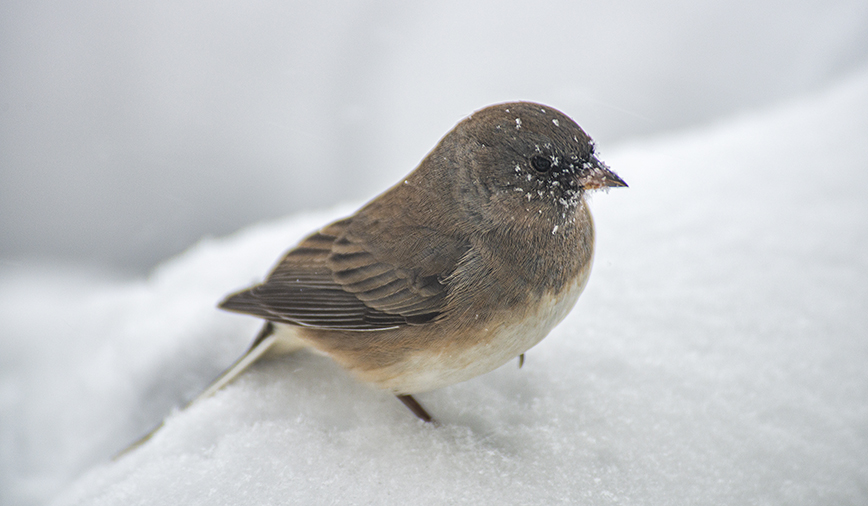February 21, 2014
Juncos
My friends make fun of me sometimes because, they say, I’m easily amused.
I guess I really can’t argue with them, since it seems like there’s rarely a time when I’m not amused—or amazed—by one or another elements of our fantastic natural world. I’ve stayed up until 2 a.m. watching a male grass spider gingerly woo a potential mate. I’ve plopped down on the sidewalk to watch an ant lug home a crumb—a feat that’s the equivalent of a human carrying school bus. And I’ve pulled the car over to the side of the road to watch a kestrel hover over a spot in a field, then dive down to capture and consume a luckless vole.
(Make that luckless, and leaky. Voles mark their trails with urine and feces. Kestrels use their keen vision, which can perceive the near-ultraviolet part of the light spectrum, to follow those UV-reflecting reflecting urine marks straight to their next meal. A-mazing!)
Lately, though, in the midst of this Winter We Won’t Soon Forget, I’ve become increasingly enamored of juncos—those little migrants from the North that many folks refer to as snowbirds. From November to March, they are daily visitors to our birdfeeders here at Hickory Knolls, as well as the shrubs and trees of my own backyard. These birds and their antics are endless sources of amusement, and amazement.
Here in the TriCities, we typically see the slate-colored junco. True to its name, it has a dark gray back, along with a light belly. Males tend to be darker than females, sometimes almost black, while females have a brownish cast. The giveaway feature is the outer tail feathers, which are white and flash when the bird flies away.
But if you travel, you may be aware of “other” juncos. Although they are members of the same species as our slate-colored birds, Junco hyemalis, these other groups exhibit a tremendous amount of geographic variation. Out west you may see “Oregon” juncos (identified by a dark head or “hood,” brown back and rufous, nearly orange flanks); pink-sided juncos; white-winged juncos; gray-headed juncos; or red-backed juncos.
Whether you’re watching juncos from a vacation veranda or in your own backyard, pay special attention to their behavior. For little birds, they have a lot to offer.
Because they’re at the small end of the bird-size spectrum, juncos are vulnerable to predation. And, like many other birds in the same boat, juncos have developed several means of protection.
For one, they form flocks. Feeding within a flock means that there are many eyes scanning the skies; individual birds can, overall, spend more time feeding and less time watching. Another advantage is that, should a predator strike, the odds favor survival for the majority of the group. That might be of little comfort to the victim that was caught unawares, but of benefit to the flock as a whole.
If, while watching flocking behavior in your juncos, you also happen to be observing them at a bird feeder, you can see yet another neat junco-ism: their pecking order. Males are dominant over females, and older birds trump younger ones. Even if you’re not 100 percent sure of the differences between males and females, I’ll bet you can sort it out just by watching who gets to feed first, and last.
If you, like me, find yourself fascinated by juncos, guess what? We’re not the only ones.
Scientists across the country have latched onto the Junco genus as a near-perfect study subject for a variety of research interests: Genetics. Migration. Hormones and physiology. Evolution.
And now, filmmakers too have been captivated by the junco and its charms. The Ordinary, Extraordinary Junco is an engaging, 88-minute documentary produced by a team of cinematographers and biologists from Indiana University.
“Juncos are easily observable by millions of people daily,” says IU researcher Jonathon Atwell, one of the film’s creators. “Depending on where you are, chances are good that you can watch this film and then go see, or hear, a junco on your way to work or school.”
Here at Hickory Knolls, we’d like to give you just that opportunity. Next Friday, February 28th, 7-9 p.m., along with our friends at Kane County Audubon, we will be cohosting a free screening of The Ordinary, Extraordinary Junco. A slide presentation of Junco facts compiled by KCA president Bob Andrini, will be followed by three select segments from the film; we’ll also provide time for discussion where you can have your junco questions answered, and share your junco stories.
It’ll be amusing, and amazing too. Hope to see you there!
Pam Otto is the manager of nature programs and interpretive services at the Hickory Knolls Discovery Center, a facility of the St. Charles Park District. She can be reached at 630-513-4346 or potto@stcparks.org.

